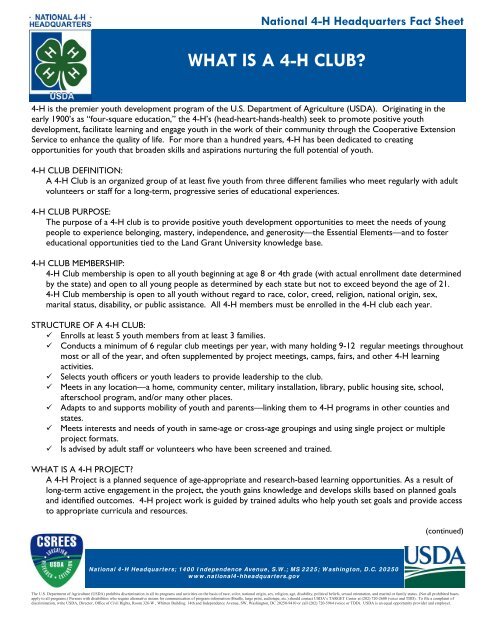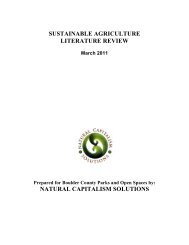What is a 4-H Club?
What is a 4-H Club?
What is a 4-H Club?
Create successful ePaper yourself
Turn your PDF publications into a flip-book with our unique Google optimized e-Paper software.
National 4-H Headquarters Fact Sheet<br />
WHAT IS A 4-H CLUB?<br />
4-H <strong>is</strong> the premier youth development program of the U.S. Department of Agriculture (USDA). Originating in the<br />
early 1900’s as “four-square education,” the 4-H’s (head-heart-hands-health) seek to promote positive youth<br />
development, facilitate learning and engage youth in the work of their community through the Cooperative Extension<br />
Service to enhance the quality of life. For more than a hundred years, 4-H has been dedicated to creating<br />
opportunities for youth that broaden skills and aspirations nurturing the full potential of youth.<br />
4-H CLUB DEFINITION:<br />
A 4-H <strong>Club</strong> <strong>is</strong> an organized group of at least five youth from three different families who meet regularly with adult<br />
volunteers or staff for a long-term, progressive series of educational experiences.<br />
4-H CLUB PURPOSE:<br />
The purpose of a 4-H club <strong>is</strong> to provide positive youth development opportunities to meet the needs of young<br />
people to experience belonging, mastery, independence, and generosity—the Essential Elements—and to foster<br />
educational opportunities tied to the Land Grant University knowledge base.<br />
4-H CLUB MEMBERSHIP:<br />
4-H <strong>Club</strong> membership <strong>is</strong> open to all youth beginning at age 8 or 4th grade (with actual enrollment date determined<br />
by the state) and open to all young people as determined by each state but not to exceed beyond the age of 21.<br />
4-H <strong>Club</strong> membership <strong>is</strong> open to all youth without regard to race, color, creed, religion, national origin, sex,<br />
marital status, d<strong>is</strong>ability, or public ass<strong>is</strong>tance. All 4-H members must be enrolled in the 4-H club each year.<br />
STRUCTURE OF A 4-H CLUB:<br />
Enrolls at least 5 youth members from at least 3 families.<br />
Conducts a minimum of 6 regular club meetings per year, with many holding 9-12 regular meetings throughout<br />
most or all of the year, and often supplemented by project meetings, camps, fairs, and other 4-H learning<br />
activities.<br />
Selects youth officers or youth leaders to provide leadership to the club.<br />
Meets in any location—a home, community center, military installation, library, public housing site, school,<br />
afterschool program, and/or many other places.<br />
Adapts to and supports mobility of youth and parents—linking them to 4-H programs in other counties and<br />
states.<br />
Meets interests and needs of youth in same-age or cross-age groupings and using single project or multiple<br />
project formats.<br />
Is adv<strong>is</strong>ed by adult staff or volunteers who have been screened and trained.<br />
WHAT IS A 4-H PROJECT?<br />
A 4-H Project <strong>is</strong> a planned sequence of age-appropriate and research-based learning opportunities. As a result of<br />
long-term active engagement in the project, the youth gains knowledge and develops skills based on planned goals<br />
and identified outcomes. 4-H project work <strong>is</strong> guided by trained adults who help youth set goals and provide access<br />
to appropriate curricula and resources.<br />
National 4-H Headquarters; 1400 Independence Avenue, S.W.; MS 2225; Washington, D.C. 20250<br />
www.national4-hheadquarters.gov<br />
(continued)<br />
The U.S. Department of Agriculture (USDA) prohibits d<strong>is</strong>crimination in all its programs and activities on the bas<strong>is</strong> of race, color, national origin, sex, religion, age, d<strong>is</strong>ability, political beliefs, sexual orientation, and marital or family status. (Not all prohibited bases<br />
apply to all programs.) Persons with d<strong>is</strong>abilities who require alternative means for communication of program information (Braille, large print, audiotape, etc.) should contact USDA’s TARGET Center at (202) 720-2600 (voice and TDD). To file a complaint of<br />
d<strong>is</strong>crimination, write USDA, Director, Office of Civil Rights, Room 326-W , Whitten Building. 14th and Independence Avenue, SW, Washington, DC 20250-9410 or call (202) 720-5964 (voice or TDD). USDA <strong>is</strong> an equal opportunity provider and employer.
National 4-H Headquarters Fact Sheet<br />
THE EDUCATIONAL AND YOUTH DEVELOPMENT PRINCIPLES OF A 4-H CLUB:<br />
Uses experiential learning—learning by doing—as a primary teaching approach.<br />
Must have programming that shows evidence of promoting the Essential Elements of 4-H Youth Development.<br />
Includes planned opportunities to learn and apply life skills such as leadership, citizenship, community service<br />
and public speaking.<br />
Provides individual project experiences to develop in-depth knowledge about science, engineering and<br />
technology; citizenship; and healthy living.<br />
Provides programs, curricula, and procedures that are based in research and are developmentally appropriate.<br />
Provides members and volunteers access to resources of land-grant universities and to county, state, and<br />
national 4-H opportunities.<br />
Fosters youth-adult partnerships that encourage active involvement and participation by youth and adults.<br />
Provides safe and healthy physical and emotional environments.<br />
Offers projects in a wide range of subject matter areas relevant to the Land Grant University knowledge base<br />
to meet youth needs and interests.<br />
PROGRAM MANAGEMENT AND IMPLEMENTATION FOR A 4-H CLUB:<br />
A 4-H <strong>Club</strong>:<br />
1. Selects its own club name. <strong>Club</strong> names must (for additional information please see the Fact Sheet on Naming<br />
4-H <strong>Club</strong>s/Units at http://www.national4-hheadquarters.gov/):<br />
a. Be specific to the 4-H club or organization either through a unique name or by identifying the county or<br />
location. Not be overtly religious or represent the beliefs of one denomination over another;<br />
b. Not imply that membership <strong>is</strong> limited or exclusive; and<br />
c. Not be offensive or generally seen as demeaning to any group protected by equal opportunity regulations.<br />
2. Develops a set of by-laws or rules approved by the members to govern the club.<br />
3. Develops an annual educational plan.<br />
4. Keeps records of their meetings and finances.<br />
5. Complies with applicable state, Land Grant University and National 4-H Headquarters’ policies.<br />
CHARTERING 4-H CLUBS:<br />
A 4-H club must be chartered by National 4-H Headquarters at the U.S. Department of Agriculture and the<br />
appropriate State 4-H Program office in order to be recognized as part of 4-H, authorized to use the 4-H Name<br />
and Emblem, and to be eligible for tax exempt status. State 4-H offices should maintain documentation on the<br />
<strong>is</strong>suance of Charters to 4-H clubs in their states. The dec<strong>is</strong>ion whether or not to charter a potential club or<br />
group <strong>is</strong> at the d<strong>is</strong>cretion of the State 4-H Program office and will not be reviewed by National 4-H Headquarters.<br />
4-H NAME & EMBLEM:<br />
The 4-H Name & Emblem <strong>is</strong> officially protected by the United States government under Title 18 U.S. Code 707.<br />
The situations in which it may be used, the manner in which it may be d<strong>is</strong>played, and the text style and colors<br />
required for its reproduction are all specified. 4-H clubs must meet these standards when using the 4-H name and<br />
emblem. Guidelines for using the 4-H Name and Emblem can be found on the National 4-H Headquarters website<br />
at http://www.national4-hheadquarters.gov/.<br />
FISCAL & TAX ISSUES FOR 4-H CLUBS:<br />
Chartered 4-H <strong>Club</strong>s may be granted an exemption for paying taxes on income generated by the club in the name<br />
of 4-H and intended to benefit the club or 4-H overall. If the club ra<strong>is</strong>es funds, it must have a federal EIN number<br />
for the club and accounting systems in place for the funds and needs to request inclusion under the federal 4-H tax<br />
exempt status. These clubs are also required to electronically file a 990-N with the IRS each year, even if they do<br />
not ra<strong>is</strong>e funds in that year. Information on 4-H tax exempt filing requirements and applications can be found on<br />
the National 4-H Headquarters website at http://www.national4-hheadquarters.gov/.<br />
(continued)<br />
National 4-H Headquarters; 1400 Independence Avenue, S.W.; MS 2225; Washington, D.C. 20250<br />
www.national4-hheadquarters.gov<br />
The U.S. Department of Agriculture (USDA) prohibits d<strong>is</strong>crimination in all its programs and activities on the bas<strong>is</strong> of race, color, national origin, sex, religion, age, d<strong>is</strong>ability, political beliefs, sexual orientation, and marital or family status. (Not all prohibited bases<br />
apply to all programs.) Persons with d<strong>is</strong>abilities who require alternative means for communication of program information (Braille, large print, audiotape, etc.) should contact USDA’s TARGET Center at (202) 720-2600 (voice and TDD). To file a complaint of<br />
d<strong>is</strong>crimination, write USDA, Director, Office of Civil Rights, Room 326-W , Whitten Building. 14th and Independence Avenue, SW, Washington, DC 20250-9410 or call (202) 720-5964 (voice or TDD). USDA <strong>is</strong> an equal opportunity provider and employer.
National 4-H Headquarters Fact Sheet<br />
RISK MANAGEMENT:<br />
R<strong>is</strong>k management policies and procedures for 4-H clubs are establ<strong>is</strong>hed by each state 4-H program. Issues<br />
concerning r<strong>is</strong>k management, including liability and accident insurance are not the responsibility of National 4-H<br />
Headquarters, CSREES, USDA and must be addressed locally.<br />
OTHER DELIVERY METHODS IN 4-H PROGRAMS:<br />
School Enrichment<br />
Afterschool Programs<br />
Day Camps and Residential Camps<br />
OTHER PROGRAM COMPONENTS:<br />
Kindergarten-3 rd Grade Programs (Cloverbuds, Cloverkids, etc.):<br />
Some states offer age-appropriate programs designed especially for children in Kindergarten through 3rd<br />
grade. These programs require more adult superv<strong>is</strong>ion and cooperative learning rather than competition.<br />
Guidelines for Kindergarten-3rd grade programs can be found on the National 4-H Headquarters website at<br />
http://www.national4-hheadquarters.gov/.<br />
Collegiate 4-H:<br />
Collegiate 4-H clubs are student organizations based on university campuses nationwide. These clubs provide<br />
opportunities for members to develop leadership skills, engage in meaningful group projects, enjoy social activities<br />
with their peers, have a sense of identity and community on campus, provide service and support to local and state<br />
communities and 4-H programs, and for many, facilitate 4-H members’ transition to 4-H volunteers or extension<br />
professionals. For more information, v<strong>is</strong>it http://www.collegiate4h.org/.<br />
Families, Independent Members, and Others:<br />
For many youth, their exposure to 4-H experiences and learning materials comes through activities conducted<br />
either within their family or as independent members. While 4-H encourages participation in club settings to<br />
promote friendships and interaction with other youth and adults, for some youth, th<strong>is</strong> <strong>is</strong> not always possible.<br />
Families and independent members are welcome to participate as part of the 4-H experience, however, the IRS and<br />
National 4-H Policies prohibit 4-H families or independent members from inclusion under the 4-H General<br />
Exemption Number as a tax-exempt entity, and from ra<strong>is</strong>ing funds for their specific family group or members.<br />
The 4-H <strong>Club</strong> Name and Emblem are held in trust by the Secretary of the United States Department of Agriculture<br />
for the educational and character-building purposes of the 4-H program and can be used only as authorized by the<br />
statute and according to the authorization of the Secretary or National 4-H Headquarters. Within each state, the<br />
State 4-H Program Office and Cooperative Extension Service has the designated authority for state and local 4-H<br />
youth development programs. Each State 4-H Program Office determines appropriate policies and practices in<br />
accordance with federal regulations, state and local policies, and university regulations. Please consult your State 4-H<br />
Program Office for more specific requirements or information related to 4-H youth development programming<br />
within your state or local area.<br />
National 4-H Headquarters; 1400 Independence Avenue, S.W.; MS 2225; Washington, D.C. 20250<br />
www.national4-hheadquarters.gov<br />
Rev<strong>is</strong>ed September 2008<br />
The U.S. Department of Agriculture (USDA) prohibits d<strong>is</strong>crimination in all its programs and activities on the bas<strong>is</strong> of race, color, national origin, sex, religion, age, d<strong>is</strong>ability, political beliefs, sexual orientation, and marital or family status. (Not all prohibited bases<br />
apply to all programs.) Persons with d<strong>is</strong>abilities who require alternative means for communication of program information (Braille, large print, audiotape, etc.) should contact USDA’s TARGET Center at (202) 720-2600 (voice and TDD). To file a complaint of<br />
d<strong>is</strong>crimination, write USDA, Director, Office of Civil Rights, Room 326-W , Whitten Building. 14th and Independence Avenue, SW, Washington, DC 20250-9410 or call (202) 720-5964 (voice or TDD). USDA <strong>is</strong> an equal opportunity provider and employer.

















